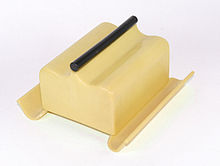Pollopas
Pollopas (probably after the chemist F. Pollack ) was the trade name of a thermosetting plastic . Made from urea resin (technically: urea - formaldehyde resin , aminoplast ), Pollopas is one of the plastics used for consumer goods since the late 1920s and is further associated with pioneering design. Today Pollopas is the name of a mirror film.
The development of urea resins such as Pollopas (or its competitor Resopal) happened at the beginning of the 20th century. Hans John's work on the condensation products, in part together with K. Ripper and W. Kraus, is set out in a number of patents and led to the manufacture of the product. Patents for Pollopas were granted in 1920–1924 by Hans John and F. Pollack. Pollopas was manufactured by Dynamit Nobel AG (DAG) in Troisdorf from 1929 and processed industrially by DAG and other pressing plants from 1931. Pollopas was used in the manufacture of various household items (cups, plates, egg cups, cruets, cutlery, cans, bowls, trays); Unsuccessful experiments were also carried out in the 1920s with its suitability for contact lenses. The products from Pollopas sold by DAG itself are considered to be extremely future-oriented in terms of their color and shape. The ceramicist and designer Ludwig König designed most of the DAG's Pollopas household goods. With the beginning of the Second World War in 1939, the civilian production of pollopas was stopped; this was only allowed to be used for armaments; the factory in Troisdorf switched to the production of self-sealing aircraft tanks and propellers made of resin-soaked hardwood.
The specific properties of the material lead to significantly lower production temperatures and pressures than with related phenolic resins such as Bakelite and thus allow a wide range of dyes to be added. This is also favored by the light basic color. The Pollopas products were characterized in particular by their bright, bright colors, while pressed phenolic resin products had dark colors due to production (cast phenolic resins such as “ Edelkunstharz ” (D) or “ Catalin ” (USA) were also very colorful, but not food-safe). Pollopas was a little more expensive than phenolic resin.
More recently, in connection with early industrial design, there have been discussions about “modern” products with “good shape” in the 1930s (i.e. later in the early days of National Socialism ). Often the point is to show that the traditional lines of classical modernism did not break off completely after 1933, despite the persecution and despite ideologically motivated personnel decisions. Unless they were made during the Weimar Republic at the end of the 1920s, many products could still be designed by well-known designers from the Weimar period during the National Socialist era. In other industrial nations , designers have also designed articles in phenoplast or aminoplast , but more in the Art Deco (GB) or Streamline style (USA).
literature
- Günter Lattermann: Formica - much more than laminate . In: Romana Schneider, Ingeborg Flagge (Hrsg.): Original Resopal. The aesthetics of the surface . jovis Verlag, Berlin 2006, ISBN 978-3-939633-04-4 , pp. 10–20 (also catalog of the exhibition of the same name, Deutsches Architekturmuseum , November 25, 2006 to February 11, 2007; German and English)
- Pollopas, a new, crystal clear, unbreakable plastic. In: Polytechnisches Journal . 341, 1926, pp. 168-169.
